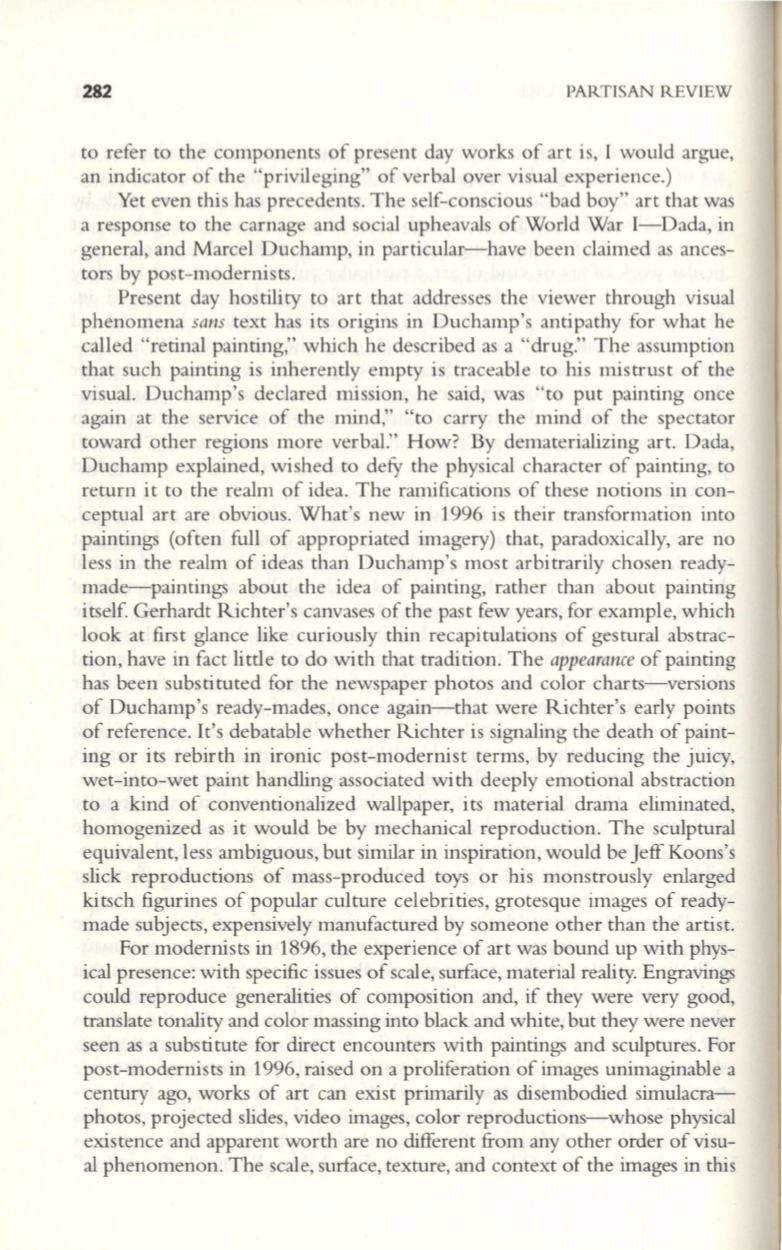
282
PARTISAN REVIEW
to refer to the components of present day works of art is, I would argue,
an indicator of the "privileging" of verbal over visual experience.)
Yet even this has precedents. The self-conscious "bad boy" art that was
a response to the carnage and social upheavals of World War I-Dada, in
general, and Marcel Duchamp, in particular-have been claimed as ances–
tors by post-modernists.
Present day hostility to art that addresses the viewer through visual
phenomena
sans
text has its origins in Duchamp's antipathy for what he
called "retinal painting," which he described as a "drug." The assumption
that such painting is inherently empty is traceable to his mistrust of the
visual. Duchamp's declared mission, he said, was "to put painting once
again at the service of the mind," "to carry the mind of the spectator
toward other regions more verbal." How? By dematerializing art. Dada,
Duchamp explained, wished to defy the physical character of painting, to
return it to the realm of idea. The ramifications of these notions in con–
ceptual art are obvious. What's new in 1996 is their transformation into
paintings (often full of appropriated imagery) that, paradoxically, are no
less in the realm of ideas than Duchamp's most arbi trarily chosen ready–
made-paintings about the idea of painting, rather than about painting
itself. Gerhardt Richter's canvases of the past few years, for example, which
look at first glance like curiously thin recapi tulations of gestural abstrac–
tion, have in fact little to do with that tradition. The
appearance
of painting
has been substituted for the newspaper photos and color charts-versions
of Duchamp's ready-mades, once again-that were Richter's early points
of reference. It's debatable whether Richter is signaling the death of paint–
ing or its rebirth in ironic post-modernist terms, by reducing the juicy,
wet-into-wet paint handling associated with deeply emotional abstraction
to a kind of conventionalized wallpaper, its material drama eliminated,
homogenized as it would be by mechanical reproduction. The sculptural
equivalent, less ambiguous, but similar in inspiration, would be Jeff Koons's
slick reproductions of mass-produced toys or his monstrously enlarged
kitsch figurines of popular culture celebrities, grotesque images of ready–
made subjects, expensively manufactured by someone other than the artist.
For modernists in 1896, the experience of art was bound up with phys–
ical presence: with specific issues of scale, surface, material reality. Engravings
could reproduce generalities of composition and, if they were very good,
translate tonality and color massing into black and white, but they were never
seen as a substitute for direct encounters with paintings and sculptures. For
post-modernists in 1996, raised on a proliferation of inlages unimaginable a
century ago, works of art can exist prinurily as disembodied simulacra–
photos, projected slides, video images, color reproductions-whose physical
existence and apparent worth are no different from any other order of visu–
al phenomenon. The scale, surface, texture, and context of the images in this


